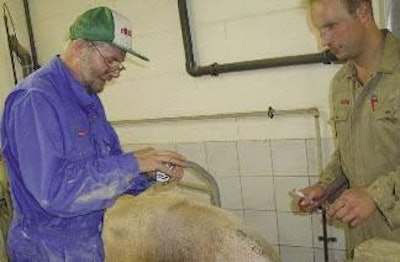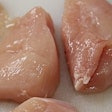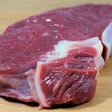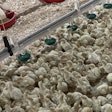
A pork supply scheme that started officially in southern Germany at the end of last year claims to be Europe's first working example of the use of DNA for full traceability of pigmeat from the point of purchase back to the farm of origin.
This German project involves a network of 38 producers in Bavaria. They belong to a producer union devoted to the generation of high-quality pork from certified facilities meeting all standards and regulations for animal welfare and food hygiene. The pigmeat from all the participating units is marketed as Franken Premium Pork to highlight its regional origins and special sourcing.
To ensure that the meat is completely traceable, their membership of the organisation now also requires them to submit a sample of hair from their breeding pigs to a laboratory where the DNA profile of the individual animal is determined. The so-called genetic fingerprint is then lodged with a central on-line database so that it can be used later in proving the parentage of slaughter pigs whenever necessary.
Although field-tested over the last 2 years, the project can in fact trace its own history back for almost a decade. It began with an idea by German pig specialists Professor Josef Lorenz and Dipl.-Ing.agr. Friedrich Berkner at the university city of Giessen, to create a limited company for integrated and certified pig production. The idea grew quickly into Integrierte Zertifizierte Schweineproduktion (IZS GmbH) defined by Mr Berkner as a community of piglet producers with the united aim of improving the performance of their enterprises.
"The central point was to increase the output potential of each herd by using better genetics," he says. "The herds needed to switch over to healthier, more efficient breeding animals on a long-term basis and there would be obvious advantages in having the same source of genetics for every member. As part of that process, some pigs were imported from the Scapaag/Multigene co-operative in France. That relationship has grown: we have sold breeding pigs from the co-operative in the southern part of Germany since March 2002. They are especially popular in this area as a source of the Duroc lines that the meat trade prefers.
"In our development of IZS, however, we also realised that the piglets from these herds should be independently certified as having been produced according to declared standards. When the first reports appeared from countries such as Canada and Japan, about achieving traceability with meat by means of a DNA analysis in the animal sector, we decided to incorporate this aspect along with the certification. We see it as the only way to make sure these pigs really stand out from the mass of quality seals and certificates in the modern marketplace and therefore have the chance to capture an exclusive market segment."
Today this process has evolved into the 38-member Bavarian venture Interessen Gemeinschaft Zertifizierung GbR, formally unveiled in the southern town of Rothenburg during October with presentations from regional officials and professors from the University of Munich. The launch information about IGZ classified the current membership as consisting of 18 piglet producers, 16 finishing-only enterprises and 4 closed farrow-to-finish herds. It also calculated that these privately-owned operations produced approximately 100 000 piglets annually from a total of 4500 sows and controlled some 23 000 grow-finish places capable of marketing 60 000 slaughter pigs per year.
IGZ's method of DNA analysis for traceability was devised by Munich university researcher Dr Ruedi Fries as part of an overall development process that is reckoned to have cost approximately one million Euros to complete. But local-government support for this process, including a grant of 820 000 from the 2 Bavarian ministries of consumer protection and agriculture as well as from Germany's Centrale Marketing Gesellschaft der deutschen Agrarwirtschaft (CMA), has limited the need for high operational costs in practice.
Tracing starts in the live animal. DNA analysis is of samples of hair collected from all sows and boars used in production. For each genotyping test, undertaken by a specialised laboratory at Weihenstephen, scheme members pay only about 25 per animal.
Every piglet born that goes on to be slaughtered as a finishing pig can be pursued back for its origin without any previous registration of its own individual DNA code, says Mr Berkner. Traceback can even be done after each carcase has been broken up into hundreds of different cuts and pieces through several different production lines. All that is needed for the detective work is a minimum of about 1 square centimetre of meat.
A clear allocation of each piece is possible because of the combination of typical DNA analysis market genes of the 2 parent animals and the information from the operating records used by the farms in their pork production. In practice it means that the 55-60 piglets produced per sow lifetime in those herds need fewer than 10 DNA analyses for their traceability to be secured.
It is a minimal cost when expressed per kilogram of pork produced, Mr Berkner declares, with the added attraction that the process is unique in giving 100% reliable traceability.
"Costs for analysing the DNA in tissue samples are falling all the time," he continues. "Look at the applications for this type of analysis that have emerged in different countries. There is now a growing use of genetic fingerprinting to identify pet dogs and cats, for example, and horses exported from a European country will soon need to have official passport documents that include DNA identification.
"My colleagues in this IGZ programme have now shown that the same approach works for pigs and pork. It is reliable and affordable. Our units were already certified as producing according to the requirements of the quality management standard ISO 9001. With the start of the genetic database they can also state today that their premium-quality pork is totally traceable."




.jpg?auto=format%2Ccompress&fit=crop&h=167&q=70&w=250)












